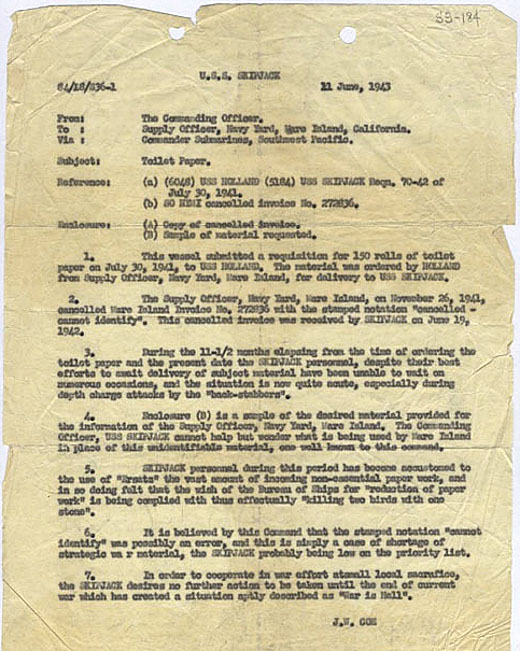The military supply system is stupid and messed up. Everything has a stock number and a description. They frequently don’t make sense. For example, a flyswatter is referred to as “Exterminator, Insect, Manual.” When I was a new E-4, I was forced into the role of Supply Petty Officer for the workcenter by the E-4 who was previously the most junior. He was glad to be rid of the job. I was soon to understand why.
On July 1, 1941, a requisition was submitted for 150 rolls of toilet paper by an officer aboard the submarine USS Skipjack (SS-184). As the boat patrolled the Pacific, the requested item never arrived. In March 1942, Lieutenant Commander James Coe took command of the Skipjack. As Coe settled into his new role, he learned of the missing toilet paper. On June 19, Coe received a canceled invoice for 150 rolls of toilet paper. The request was the original from July 1941 and was stamped “canceled-cannot identify.” Coe wrote a response that is famous within the Navy today.

1. This vessel submitted a requisition for 150 rolls of toilet paper on July 30, 1941, to USS HOLLAND. The material was ordered by HOLLAND from the Supply Officer, Navy Yard, Mare Island, for delivery to USS Skipjack.
2. The Supply Officer, Navy Yard, Mare Island, on November 26, 1941, cancelled Mare Island Invoice No. 272836 with the stamped notation “Cancelled—cannot identify.” This cancelled invoice was received by Skipjack on June 10, 1942.
3. During the 11 1/2 months elapsing from the time of ordering the toilet paper and the present date, the Skipjack personnel, despite their best efforts to await delivery of subject material, have been unable to wait on numerous occasions, and the situation is now quite acute, especially during depth charge attack by the “back-stabbers.”
4. Enclosure (2) is a sample of the desired material provided for the information of the Supply Officer, Navy Yard, Mare Island. The Commanding Officer, USS Skipjack cannot help but wonder what is being used in Mare Island in place of this unidentifiable material, once well known to this command.
5. Skipjack personnel during this period have become accustomed to use of “ersatz,” i.e., the vast amount of incoming non-essential paper work, and in so doing feel that the wish of the Bureau of Ships for the reduction of paper work is being complied with, thus effectively killing two birds with one stone.
6. It is believed by this command that the stamped notation “cannot identify” was possible error, and that this is simply a case of shortage of strategic war material, the Skipjack probably being low on the priority list.
7. In order to cooperate in our war effort at a small local sacrifice, the Skipjack desires no further action be taken until the end of the current war, which has created a situation aptly described as “war is hell.”
J.W. Coe
Coe’s letter caused quite a stir and was circulated throughout the fleet. When the Skipjack returned to Australia after her patrol, she was greeted by quite a sight. The pier was stacked seven feet high with boxes of toilet paper instead of the usual crates of fresh fruit and ice cream. Toilet paper streamers decorated the dock, and a band greeted the boat wearing toilet paper neckties and toilet paper flying out of trumpets and horns. The men of the Skipjack would not have to do without toilet paper again, as they were greeted upon every return with cartons of the precious paper.
Back to my story: we had an upcoming deployment, and I had to order supplies to get us through the first six months. I was told to order some superglue and some wooden handled cotton swabs. I looked them up, and the superglue was listed as “adhesive, cyanoacrylate” with a unit of issue of CS (meaning case) and a unit cost of $1.44. The cotton swabs were listed as “applicator, cotton tip, wood handle” with a unit of issue of BG (bag) and a cost of $0.29. No mention in either case of how many were in a case or a bag. At the time, the military was known to be paying $400 for a hammer, so I had to guess.
I guessed that there were at most 2 tubes of superglue per case, and ordered 12 units of superglue, and that there were at most 10 swabs per bag, so I ordered 100 bags of them. What it turned out was that there were 144 tubes of glue per case, and 100 swabs per bag. I wound up with 1,700 tubes of superglue and 10,000 cotton swabs. This mistake was legendary. I caught shit about it for the entire deployment.
When I passed the job on to the newly promoted guy a few months later, I was evil about it. We sent him down to supply to get a can of eh-eye-arr. He came back to supply with a bottle marked “Air, room temperature.” He got the best of me.


